Parthon de Von family
The Parthon de Von family is a French and Belgian family of Scottish origins, first mentioned in 1421, with a documented ancestry dating back to 1575 and ennobled by King Leopold I.[9]
| Parthon de Von | |
|---|---|
| European Roman Catholic noble family | |
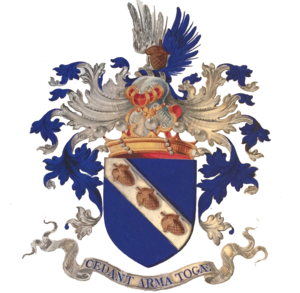 | |
| Country | (before 1421) (1421-1830) (since 1830) |
| Current region | Western Europe |
| Earlier spellings | Parton Parthon[1] |
| Place of origin | Gulf of Solway |
| Founded | 1400s |
| Distinctions | Legion of Honour Order of the Crown Medal of French Gratitude[2] Order of Isabella the Catholic[3] National Order of Merit Decoration of The Lily[4] |
| Traditions | Roman Catholicism |
| Motto | (English: Let arms yield to the toga) |
| Estate(s) | Château de Von[5] Château de Middelheim[6] Château du Cornet[7] Château de La Poudrière[8] |
It notably produced a captain in the Scottish Army, three mayors of Châteauroux, lawyers, counselors and parliamentarians in France, a burgomaster and two diplomats in Belgium, etc.
Origin
Anglo-Scottish origins (before 1421)
The Partons gave their name to two lordships on each two banks of the Gulf of Solway and the other on the British coast.[10] One is watered by Parton Bay in the county of Cumbria in England, the other by the River Dee in the county of Kirkcudbright in Scotland.[11]
In the context of the Auld Alliance, between 5,000 and 6,000 Scots landed in La Rochelle in 1421 to lend a hand to the French during the Hundred Years' War.[12] According to genealogists and medievalists Tausserat, de Chevilly and Count Paul-Alexandre du Chastel de La Howarderie, it was with this trip that the Partons settled in Berry, France.[13]

Development in Châteauroux (1421-1830)
Following the handing over of the city of Aubigny by Charles VII to the Scottish army chief John Stewart of Darnley, the Partons settled in Châteauroux. Its members held administrative and judicial functions there between the sixteenth century and the eighteenth century. In 1720, Michel Parthon, one of the leaders of the bourgeois militia of Châteauroux, bought the land from Von to Saint-Maur.[14] It returned to Sulpice Parthon, who belonged to the administration of this city in 1776, and gave its name to the rue de Von and the chemin du Moulin de Von in Saint-Maur.[15]
.jpg.webp)
Establishment in Belgium (since 1830)
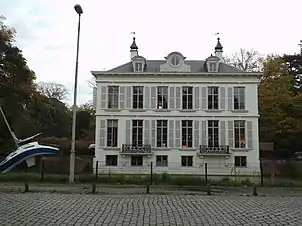
After the July Revolution that made Louis-Philippe come to power in France, the Knight Parthon de Von (1788–1877) moved to Belgium, disinclined to serve the new government as vice-consul of France.[16] In the château de Middelheim he wrote the Fables (1843). Achieved horticulturist, he helped Louis van Houtte collect orchids in Brazil for King Leopold I and the Royal Greenhouses. Charles Morren dedicated the malaxis orchidaceae parthoni. The Knight Parthon de Von invented multiple parents, including the first foldable baby-carrier, etc.
The family settled in Anvers, Soignies, Tournai and Brussels. It notably produced two diplomats, in particular on behalf of Spain and Argentina, a burgomaster of Horrues in 1890, a prisoner of war from 1939 during World War II, etc.
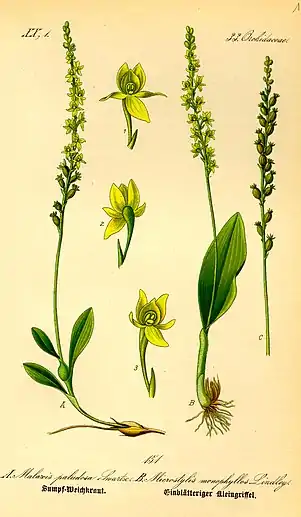
Notable members
- Hedwick Parton paid hommage to Henry VI in 1430.
- Henry Parton, frigate lieutenant, captain of the Scottish army.
- Pierre Parthon (1637–16..), échevin and mayor of Châteauroux.[9]
- Guillaume Parthon (1644-1699), oculist surgeon of Louis XIV, author.[17]
- Pierre Parthon (1649–1727), échevin and mayor of Châteauroux.
- François Parthon (1683–1723), lawyer in parliament, fiscal lawyer of the duchy, mayor of Châteauroux.[18]
- Sulpice Parthon (1714–1793), king's counsellor (bailiwick of Châteauroux), fiscal lawyer of the duchy, king's advocate general.[19]
- Sébastien Parthon de Von (1751–1818), king's advocate general, justice of the peace, canton president (Saint-Germain-en-Laye).
- Édouard, 1st Knight Parthon de Von (1788–1877), diplomat, royal military attaché to Louis XVIII, horticulturist, author (Les Fables).[16]
- Henri, 3rd Knight Parthon de Von (1858–1932), burgomaster of Horrues, president of the Belgian Society of Inventors, patent author.[20][21]
- Alphonse, 4th Knight Parthon de Von (1881–1945), diplomat during World War I and II representing France and later Spain and Argentina.[22]
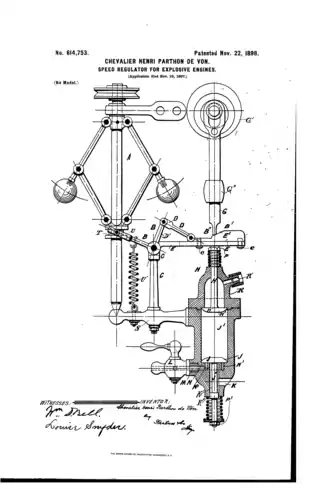
Seigneurial domains owned
- Lordship of Von
The first Lord of Von was Michel Parthon, colonel in 1715, and son of Pierre, lawyer, mayor of Châteauroux in 1664. After his death Sulpice-Étienne Parthon inherited the domain. The castle of Von is between the cities of Saint-Maur and Châteauroux.[18]
Sébastien Ruby, general of the Revolutionary and Napoleonic Wars, lived in the castle between 1808 and 1809.[23]
Genealogy
The following is an agnatic primogeniture succession of members of the Parthon de Von family since 1575:
- Estienne Parthon (1575–16..) ∞ Marguerite de Billon (15..–16..)
- Estienne Parthon (1610–1644) ∞ Catherine Catherinot de Villechaise (16..–1...)
- Pierre Parthon (1649–1727) ∞ Marie de Basset (16..–1...)
- François Parthon (1683–1723) ∞ Jeanne Guymon de Brelay (16..–1...)
- Sulpice-Étienne Parthon de Von (1714–1793) ∞ Marie Pelletier de Martainville (17..–1...)
- François Parthon de Von (1753–18..) ∞ Andrée Thoinnet de La Turmelière (1761–1...)
- Édouard, 1st Knight Parthon de Von (1788–1877) ∞ Dame Jeanne Van de Velde (1796–1847)
- Édouard-Émile, 2nd Knight Parthon de Von (1814–1897) ∞ Countess Amélie de Coopmans-Yoldi (1828–1890)
- Henri, 3rd Knight Parthon de Von, (1858–1932) ∞ Dame Marie Fontaine de Ghélin (1859–1931)
- Alphonse, 4th Knight Parthon de Von (1881–1945) ∞ Dame Yvonne de Séjournet de Rameignies (1885–1971)
- Henri, 3rd Knight Parthon de Von, (1858–1932) ∞ Dame Marie Fontaine de Ghélin (1859–1931)
- Édouard-Émile, 2nd Knight Parthon de Von (1814–1897) ∞ Countess Amélie de Coopmans-Yoldi (1828–1890)
- Édouard, 1st Knight Parthon de Von (1788–1877) ∞ Dame Jeanne Van de Velde (1796–1847)
- François Parthon de Von (1753–18..) ∞ Andrée Thoinnet de La Turmelière (1761–1...)
- Sulpice-Étienne Parthon de Von (1714–1793) ∞ Marie Pelletier de Martainville (17..–1...)
- François Parthon (1683–1723) ∞ Jeanne Guymon de Brelay (16..–1...)
- Pierre Parthon (1649–1727) ∞ Marie de Basset (16..–1...)
- Estienne Parthon (1610–1644) ∞ Catherine Catherinot de Villechaise (16..–1...)
Armorial
Heraldry
 |
|
Ennoblement and Titles
He received a confirmation and concession of nobility with the hereditary title of knight by letters patent in Belgium.[Note 1] The titles worn are squire, Jonckeer / Jonkvrouw, knight and ridder. Its Chief of the Name and Arms is François, 6th Parthon Knight of Von since 1989, and the Heir apparent Gautier, 7th Squire Parthon of Von since 1996.

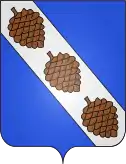
Sepulture
It holds a perpetual concession for its members in the Laeken Cemetery in proximity to the Royal Crypt and the Church Our Lady of Laeken.[26]
Alliances
Blanchard, Pelletier de Martainville (1749),[27] Legrand (1772),[19] Thoinnet de La Turmelière (1779),[28] van de Velde (1813),[29] de Coopmans-Yoldi (1849),[27] Cogels (1871),[30] Fontaine de Ghélin (1880),[27] du Bois (1880),[27] de Séjournet de Rameignies (1905),[27] de La Kethulle de Ryhove (1928),[27] de Bonnières (1962),[27] Béchet de La Peschardière (1984), d'Eimar de Jabrun.[24]
Resources
Related articles
Bibliography
- Oscar Coomans of Brachène, this State of the Belgian nobility, the 1979 Yearbook, second part P-Pos, Brussels, 1979.
- Jean-François Houtart, Belgium Old families, LXI Collection of the Royal Family Office Association and heraldry of Belgium, Brussels, 2008.
- Directory of Belgian nobility, 1851.
Notes
- It is a kind of additional guarantee. Based on the documents presented, the ancien régime nobility of a person is confirmed, but in the situation where the authority nevertheless raises certain questions about the quality of previous nobility, it adds that, insofar as necessary, the nobility is also conceded, for the case it would appear later that the confirmation was based on insufficiently reliable data. This has been encountered on several occasions. Indeed a concession of nobility made under the old regime, sometimes lent the flank to doubts. If it had been conceded by the Holy Roman Empire, had it or not been confirmed by the Heraldic Chamber of the Austrian Netherlands, failing which it would not be valid, ditto for the concessions granted by one or the another head of one of the small German states, or by the king of France or Spain. In order to avoid both the impetrant and the conceding authority any disappointment, it was therefore a way of guaranteeing the state of nobility by adding this "if necessary ".
References
- Généalogie de la famille Parthon, Babou, édité par la Revue du Berry en janvier 1907
- Journal officiel, 21 décembre 1919. Gallica
- L. Verriest, Un livre de raison des Séjournet, notable lignée féodale du pays d'Ath, in: Annales du Cercle d'archéologie de Soignies, 1946.
- https://www.legifrance.gouv.fr/affichTexte.do?cidTexte=JORFTEXT000035980015
- Architectures en Région Centre", Volume 1 de Guide du patrimoine. Jean-Marie Pérouse de Montclos, Éditeur Conseil régional du Centre, (1988)
- Bulletin de la Société royale belge de géographie, Volume 10, 1886, page 667.
- Ministère de la région wallonne / division du patrimoine, Notice J.D., Le patrimoine monumental de la Belgique, Hainaut, Arrondissement de Soignies, Éditions Mardaga, 1997, p. 752.Lire en ligne.
- https://www.delcampe.net/fr/collections/faire-part/mariage/faire-part-mariage-baron-du-bois-parthon-de-von-othon-antoinette-gaiffier-demeville-chateau-de-la-poudriere-maisieres-400645527.html
- Archives départementales du Cher et de l'ancienne province du Berri E 1628
- Bonner, Elizabeth (January 1999). "Scotland's 'Auld Alliance' with France, 1295-1560". History. 84 (273): 5–30. doi:10.1111/1468-229x.00097. ISSN 0018-2648.
- Talbott, Siobhan (November 2011). "Beyond 'the Antiseptic Realm of Theoretical Economic Models': New Perspectives on Franco-Scottish Commerce and the Auld Alliance in the Long Seventeenth Century". Journal of Scottish Historical Studies. 31 (2): 149–168. doi:10.3366/jshs.2011.0019. ISSN 1748-538X.
- MacDonald, Alastair J. (May 2000). "The Apogee of the 'Auld Alliance' and the Limits of Policy, 1369-1402". Northern Scotland. 20 (First Series) (1): 31–46. doi:10.3366/nor.2000.0003. ISSN 0306-5278.
- DUROT, Éric (2007). "Le crépuscule de l'Auld Alliance : la légitimité du pouvoir en question entre Écosse, France et Angleterre (1558-1561)". Histoire, économie & société. 26e année (1): 3. doi:10.3917/hes.071.0003. ISSN 0752-5702.
- Simonin, Jean-Pascal (2006), "Edmond Charlemagne, député de l'Indre, et les émeutes frumentaires de Châteauroux en 1829", Pour une histoire sociale des villes, Presses universitaires de Rennes, pp. 265–278, doi:10.4000/books.pur.25443, ISBN 978-2-7535-0290-1, retrieved 2020-12-18
- Lasteyrie, Ferdinand de (1875). Histoire de l'orfévrerie depuis les temps les plus reculés jusqu' à nos jours. Hachette et cie. doi:10.5479/sil.181497.39088003366614.
- Bulletin de la Société royale belge de géographie, Volume 10, 1886, page 667
- Thevenin, François; Parthon (1691). Les Oeuvres de Maitre François Thevenin... recueillies par Maître Guillaume Parthon... (in French). Chez Jean Certe. p. 153.
guillaume parthon.
- Histoire de Déols et de Châteauroux, Volume 2, Res Universis, 2000, page 661.
- Grands notables du Premier Empire: Indre, Centre national de la recherche scientifique, 1994, page 203
- Parthon de Von Henri, chevalier. "Speed regulator for explosive engine". brevet US614,753. 22 novembre 1898
- Parthon de Von Henri, chevalier. "Baby carriage". brevet US609,520. 23 août 1898
- Marie-Pierre d'. Udekem d'Acoz , Pour le roi et la patrie, Racine, 2002 - Page 16
- Duplaix, Jean (1982). Sébastien Ruby: un enfant du Berry, général de la Révolution et de l'Empire, 1755-1809 (in French). J. Duplaix.
- État présent de la noblesse belge, 2006, t. 2, p. 268
- Service des archives de Nantes, Répertoire Municipal, fonds vicomte de Freslon, relevés d'actes paroissiaux de familles notables
- Bulletin usuel des lois et arrêtés: concernant l'administration générale
- Oscar Coomans de Brachène, État présent de la noblesse belge, Annuaire de 1979, seconde partie P-Pos, Bruxelles, 1979.
- Thoinnet de la Turmelière
- "opac.kbr.be, Messager De Gand (Le) 31-01-1847, nécrologie". Archived from the original on 2016-09-11. Retrieved 2016-12-14.
- Oscar Coomans de Brachène & Georges de Hemptinne, Cogels, in État présent de la noblesse belge, Annuaire de 1972, seconde partie, Can - Col, Bruxelles, 1972, p. 310.

.jpg.webp)
.jpg.webp)